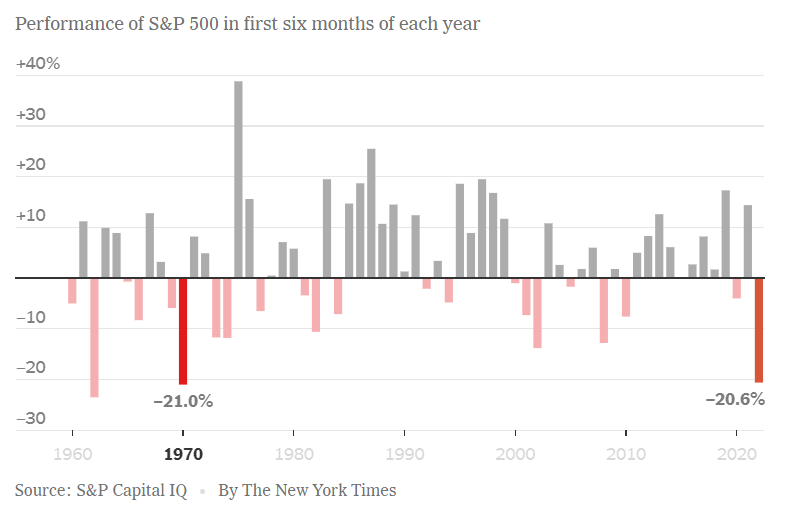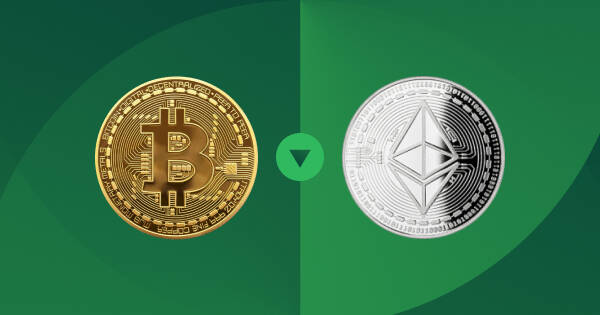เมื่อไหร่ตลาดหุ้นสหรัฐฯ จะถึงจุดต่ำสุด?
เศรษฐกิจอยู่ในภาวะถดถอย ประสบภาวะเงินเฟ้อสูง และอัตราดอกเบี้ยสูง มันทำให้เงินเดือนนั้นมีมูลค่าน้อยลง ทำให้ความเชื่อมั่นของผู้บริโภคอ่อนแอลง และอาจนำไปสู่การเลิกจ้างบริษัทต่างๆ ด้วยความตึงเครียดเหล่านี้ หุ้นจึงร่วงลงสู่ตลาดหมี
หุ้นสหรัฐฯ ได้มีช่วงครึ่งปีแรกที่แย่ที่สุดในรอบกว่า 50 ปี เนื่องมาจากความพยายามของธนาคารกลางสหรัฐฯ ในการควบคุมเงินเฟ้อและความกังวลที่เพิ่มขึ้นเกี่ยวกับภาวะเศรษฐกิจถดถอย และการเติบโตของเศรษฐกิจทั่วโลก แล้วหุ้นสหรัฐฯ จะเป็นอย่างไรต่อไปล่ะ? หุ้นเหล่านั้นจะสามารถฟื้นตัวในช่วงครึ่งหลังของปี 2022 ได้หรือไม่?
S&P 500 ผ่านช่วงครึ่งแรกของปี 2022 ด้วยตัวเลขที่ไม่ดีนัก โดยร่วงลงมากกว่า 20.6% Wall Street ไม่เคยเห็นการเริ่มต้นที่รุนแรงเช่นนี้มาก่อนนับตั้งแต่ปี 1970 เมื่อหุ้นต่างๆ เห็นการเทขายออกอย่างแข็งแกร่งในภาวะเศรษฐกิจถดถอยที่สิ้นสุดระยะเวลาการขยายตัวทางเศรษฐกิจที่ยาวนานที่สุดในประวัติศาสตร์ของสหรัฐอเมริกาจนถึงตอนนี้
Nasdaq Composite ที่เน้นด้านเทคโนโลยีได้สูญเสียไปแล้วเกือบ 30% ตั้งแต่ปี 2022 หุ้นสหรัฐฯ ที่ร่วงลงอย่างรวดเร็วได้กวาดล้างมูลค่าตลาดไปแล้วกว่า 9 ล้านล้านดอลลาร์สหรัฐ นับตั้งแต่สิ้นปี 2021 ตามข้อมูลของ Bloomberg สำหรับดัชนี S&P 500

เหตุใดหุ้นสหรัฐฯ จึงเข้าสู่ตลาดหมี?
1. ปีนี้อัตราเงินเฟ้อถือเป็นประเด็นสำคัญ และผลกระทบที่รุนแรงของเงินเฟ้อได้ส่งผลกระทบต่อทุกสิ่งทุกอย่าง
2. Fed ดื้อดึงและตอบสนองต่ออัตราเงินเฟ้อที่เพิ่มสูงขึ้นช้าเกินไป แม้ว่าจะมีสัญญาณต่างๆ มาตั้งแต่แรกว่าราคาที่สูงขึ้นนั้นไม่ได้เกิดขึ้นเพียงชั่วคราวและจะคงอยู่ต่อไป
3. ขณะนี้อารมณ์ที่มืดทะมึนและบรรยากาศเชิงลบกำลังครอบงำตลาด โดยมีความเป็นไปได้ที่จะเกิดภาวะเศรษฐกิจถดถอยในสหรัฐอเมริกาและยุโรป
4. การที่ธนาคารกลางไม่สามารถกระชับนโยบายและปรับขึ้นอัตราดอกเบี้ยในเวลาที่เหมาะสม และความล้มเหลวในการควบคุมเงินเฟ้อได้ ซึ่งนั่นเป็นหน้าที่ของธนาคารกลางในการดำเนินการนโยบายการเงินเพื่อรองรับการเติบโตทางเศรษฐกิจ
5. การปรับขึ้นอัตราดอกเบี้ยหลายๆ ครั้งนั้นเกิดขึ้นอย่างรวดเร็วและรุนแรงจนทำให้ตลาดสับสนอย่างมาก
6. การที่ Fed ยืนกรานที่จะขึ้นอัตราดอกเบี้ยอย่างต่อเนื่องเพื่อต่อสู้กับภาวะเงินเฟ้อ แม้ว่าจะมีความเสี่ยงทางเศรษฐกิจที่อาจจะนำไปสู่ภาวะเศรษฐกิจถดถอยก็ตาม
ตลาดหุ้นจะเป็นอย่างไรในช่วงครึ่งหลังของปี 2022?
หุ้นได้เผชิญปัญหาตั้งแต่ตกลงมาสู่ตลาดหมีในเดือนมิถุนายน จากสถิติในอดีตแสดงให้เห็นว่าการร่วงลงอย่างรวดเร็วของตลาดในปีนี้อาจเป็นสัญญาณเชิงบวก โดยหุ้นเตรียมพร้อมที่จะดีดตัวขึ้น หากเศรษฐกิจหลีกเลี่ยงภาวะเศรษฐกิจชะลอตัวหรือภาวะเศรษฐกิจถดถอยอย่างรุนแรงได้
ข่าวดีก็คือตลาดกระทิงล่าสุดนั้นใช้เวลาเพียง161 วัน ในการเปลี่ยนจากที่ระดับสูงสุดแล้วร่วงลงมา 20% เมื่อเทียบกับค่าเฉลี่ย 245 วันในตลาดหมีครั้งก่อนหน้า
หาก Fed หลีกเลี่ยงภาวะเศรษฐกิจถดถอยเหมือนในวิกฤตฟองสบู่ดอทคอม (2000-2002) และวิกฤตโลก (2008-2009) ได้ ตลาดหมีนี้อาจถึงจุดต่ำสุดในไม่ช้า ตลาดหมีนี้จะจบลงอย่างไรขึ้นอยู่กับอัตราเงินเฟ้อที่ลดลง ซึ่งจะกำหนดระยะเวลาว่า Fed จะขึ้นอัตราดอกเบี้ยต่อไปอีกนานเท่าไรและจะหยุดลงเมื่อใด
แนวโน้มของดัชนี S&P 500 เป็นอย่างไรบ้าง?
หาก Fed ควบคุมอัตราเงินเฟ้อในเดือนต่อๆ ไปนับจากนี้ได้ ตลาดจะทรงตัวและสงบลง หาก Fed ทำไม่สำเร็จ ตลาดหมีนี้จะเป็นเพียงแค่จุดเริ่มต้นเท่านั้น
ด้วยสถานการณ์การชะลออัตราเงินเฟ้อและฤดูแห่งผลประกอบการที่มั่นคง เราคาดว่า S&P 500 จะส่งท้ายปีที่ระดับ 3,900-4,200 หากผลกำไรของบริษัทลดลงในอีกสองไตรมาสข้างหน้าและเศรษฐกิจเข้าสู่ภาวะถดถอย ดัชนี S&P 500 อาจลดลงต่ำกว่า 3,300
